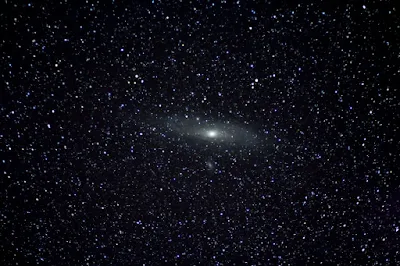 I mentioned that Billy and I had spotted the Andromeda galaxy. The photo above (not by us) is sort of close to what we saw. The astronomy books usually show these spectacular images of Andromeda in all its glory. But those pictures come from long exposures through big telescopes. Through our little six inch reflector, Andromeda looks like a cloud, not quite as defined as the one in this picture. This picture is a 4 minute exposure through an ordinary digital camera using a 300mm telephoto lens.
I mentioned that Billy and I had spotted the Andromeda galaxy. The photo above (not by us) is sort of close to what we saw. The astronomy books usually show these spectacular images of Andromeda in all its glory. But those pictures come from long exposures through big telescopes. Through our little six inch reflector, Andromeda looks like a cloud, not quite as defined as the one in this picture. This picture is a 4 minute exposure through an ordinary digital camera using a 300mm telephoto lens.(From: http://www.prairiehillfarmiowa.com/prairiehill/Home.html)
It is a real thrill to look at Andromeda. That little cloud represents 300 billion stars, and they are around 2.5 million light years away. So when you look, you know the photons hitting your retina started their trip LONG before there were homo sapiens. Icing on the cake: A satellite went through the telescope's field of view just as was looking at M31.
Another nice thing about Andromeda galaxy is that you can see it with the naked eye (you have to know where to look!). Because of this, people have been observing it for quite some time. Here is the first known drawing of M31. This is the work of the Persian astronomer Al-Sufi, and was done in year 964. The Persians imagined a constellation in the form of a fish in that part of the sky. Note the little cloud near the mouth of the fish -- that's M31.
 Until 1923 astronomers thought M31 and other "nebula" were just clouds within our galaxy. The thought was that the Milky Way was the only galaxy. But then Edwin Hubble got some distance readings (using variable stars) on Andromeda and realized that he was looking at an entirely separate galaxy. That was a BIG discovery.
Until 1923 astronomers thought M31 and other "nebula" were just clouds within our galaxy. The thought was that the Milky Way was the only galaxy. But then Edwin Hubble got some distance readings (using variable stars) on Andromeda and realized that he was looking at an entirely separate galaxy. That was a BIG discovery.
Hi Bill, wikipedia has Andromeda at 2.5 Million light years, about 1000X nearer than your figure.
ReplyDeletemike KV4FN